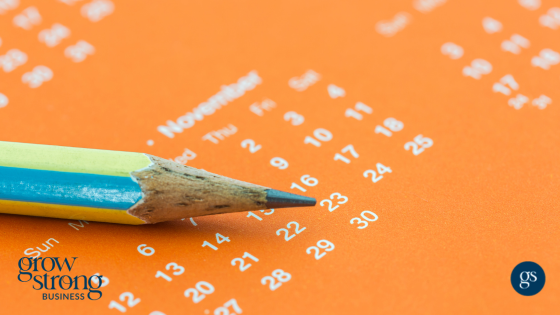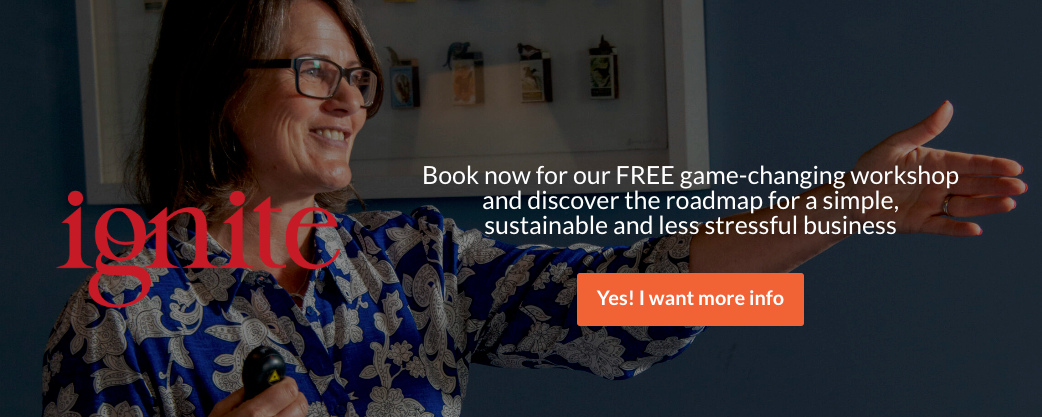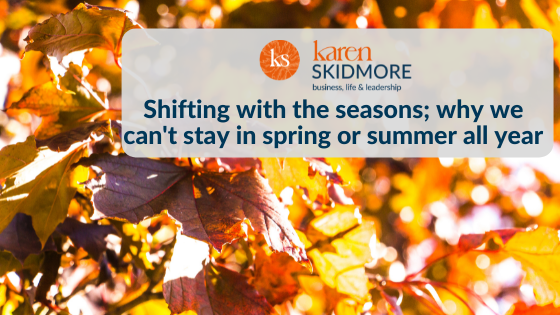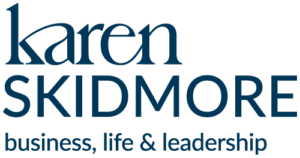
by Karen Skidmore | 03,24 | Business Planning, Ebb & Flow, Marketing Articles
Have you ever considered the timings of your monthly cycle when planning your business or deciding when to launch your next programme or speak at an event?
(Yes, this article is written for women, but if you’re a guy with women in your team, please read on because this is a serious post and can be incredibly enlightening if you’ve never considered this in your business!)
Cycle tracking is becoming an everyday conversation, at least with our clients.
It’s one of the ways you can track how your energy flows naturally and responds to external influences, such as what food we eat and how we look after our bodies, and since doing a lot of research in this area and bringing it into the work that we do with our clients, I’ve seen that creating sustainable business success is more than a well-put-together business plan or marketing funnel.
Being aware of what affects your energy and how you approach certain decisions in your business can help you design, create and run your business so your work fuels you rather than burns you out.
Why track your monthly cycle?
If you’ve ever tracked your cycle, you’ll know your energies have ebbs and flows.
I’m now post-menopausal, so I no longer have a monthly cycle; I tune into different things to track my energy flow now. But in the last few years of menstruating, I tracked my cycle to help plan my marketing campaigns and promotional events as it became a helpful barometer to tune into my ebb and flow of emotions, creativity and periodic stuck-ness.
I started to be aware of the exact dates of my cycle when my husband and I decided to start a family (ah, those fun days of taking one’s temperature to confirm ovulation days!). But it wasn’t until my adrenaline reached boiling point and my system crashed back in 2012 that I started seriously to research my peri-menopausal symptoms. I began to track my monthly cycles again.
Tracking my emotional and physical changes throughout the month helped me make sense of what was going on inside of me; the feeling of being out of control one week focused and in flow the next, often followed by a severe energy crash, irrational mood swings and my inner critic shouting down any great ideas I had for my business.
In my experience, knowing where I’ve been in my cycle at any given point in my working week has helped me enormously over the past few years to deal with things that haven’t gone according to plan … as well as helping me realise I wasn’t going mad; I’m simply a woman!
The four stages of your cycle
Your cycle has four distinct stages, each affecting your energy, emotions and physicality.
Of course, not every woman has a regular 28-day cycle; we all have our unique pattern, sometimes so irregular that it’s hard to track. But if you are still in menstrual flow, the first step in taking this approach with your business is to track and record how you feel and what symptoms you experience.
Plenty of apps to choose from today include tracking your symptoms and moods, too.
If you prefer a ‘paper’ version, I have a brilliant 28 Day Energy Tracker here that you can download for free.
Phase 1: Menstruation
Day 1 of your cycle is the first day of menses. I often found a massive sense of relief on this day, followed by a few days of general yuckiness, bloating and tiredness that worsened as I got older. It felt as if my body found it tougher each month to kick start the engine as I get closer to menopause each year.
Day 2 or 3 was a day I could have quite happily stayed in bed all day, and although walking and getting out and about brought relief, it was always vital for me to lower my pace and keep rested. I learnt from experience that to go full pelt during these days would have a knock-on effect of being knackered for weeks or even picking up a bug and getting ill. So, instead of pushing through with complex tasks, I leant back and took everything at a slower pace during these times. When I did this, it often turned out to be an incredibly productive time for me, as I pondered more, avoided making decisions and focused on creative projects such as writing, content and programme design.
Phase 2: Follicular
This phase usually lasts 7 to 10 days of your cycle, and it’s when your oestrogen and testosterone levels start to climb, getting you ready for ovulation.
I used to feel wonderful during this time, but as my peri-menopausal symptoms kicked in, the lack of oestrogen made this week tough for me for some months. It was often when I felt the most frustrated; I’d been used to surging ahead with plans and action-taking with my brain going full steam, but my body did not respond in this way in my last few years. And if I’d pushed through in my menstruation phase, I would feel a bit shit during this time!
Phase 3: Ovulatory
Lasting only a few days, your body produces your egg, and you may feel incredibly powerful; able to take on the world and say yes to everything.
It’s Mother Nature’s way of making you attractive to the opposite sex and ready to mate, of course, so this can be a fabulous time to run an event, negotiate with a new contract or even pick up the phone to prospect you’ve been putting off for an age.
Phase 4: Luteal
Typically lasting 12 to 16 days, this is the remainder of your cycle. Oestrogen and testosterone decline, and progesterone, the heat-inducing hormone, kicks in, preparing your body for a potential pregnancy. Often, you feel the most tired because Mother Nature is preparing you for ‘rest and nest’.
This phase can become an excellent time to brain dump to-do lists, clear up clutter and re-align yourself before taking action on any new projects or ideas.
And, of course, PMS can start to kick in towards the end of this last stage; from chronic back pain and stiff joints to raging anger and mood swings. So be aware that this can be a particularly stressful time to think straight or do projects such as the end-of-month accounting! So perhaps it is not the best time to reconcile your banking or respond to a negative comment on one of your Facebook posts.
What about you?
Every woman’s monthly cycle is unique to her. You will have your own symptoms and experiences; and some months go better than others. But the more aware you become of your cycle, the more effective and productive you can be in your business decisions and marketing activities.
And as marketing can be such an emotive part of your business, from deciding what price to sell at and whether to record a live video when all you want to do is climb into bed with a hot water bottle, here are some of the lessons I have learnt along the way of planning my marketing and my business around my cycles.
Lessons learnt from tracking my cycle
1. Stop beating yourself up
You can stop beating yourself up when you get frustrated something’s not working.
Being “on your period” is not about making excuses but when you are aware of how your body is responding to which hormones you are producing, it can clarify why you may be screaming at your laptop for deleting your file (because, quite obviously, it had nothing to do with you!).
2. Give yourself a break when you need it
You can give yourself a break when your body needs it most and plan to deliver your best work when you are at your best.
Planning a two-day event in the fourth week of your cycle may not the best time if you’re contending with stomach cramps and irritability so if you have control over your work calendar, choosing days in your follicular weeks could allow you to rock your best work in front of an audience.
3. Stop taking yourself so seriously
Nothing … and NOTHING … is more irritating than someone (AKA your partner) asking you if you’re PMSing … when you are PMSing.
I would often head this off at the pass once I became aware of my mood swings. When I got that first sign of irritability, I was off to check my period tracker, and then tell my husband and my children that I was on the way. I found that I could laugh about it if I were the one to bring it up first … funny how that happens!
4. Take days off when you need them
Running your own business gives you the enormous benefit of controlling your diary, so don’t make it more difficult for you or your team members than it needs to be. If you have a particularly bad PMS or find it tough on other days of your cycle, factor those days into your working calendar. Your body and brain will thank you for it when you come to your productive days, and you can turn up the energy dial.
In corporate life, taking a sick day for bad period pains can be challenging to negotiate, especially if it’s as regular as clockwork and it’s the same day of every month. Plus, trying to explain in a board meeting why your brain fog is so thick and why you have no idea why your sales figures are down this month may not go down well. However, I remember one lady who worked as a Communications Director for a small company. She began to add her cycle in her work diary after a conversation with me about his topic so she and her team could see her predicted cycle. This may be one step too far for you, but I believe the more we normalise our normal cycles as women, the better support we can get from others.
5. Get braver on your brave days
This was a game-changer for me!
Add this cycle time to your diary if you know you’re raring to go during your follicular week. Plan your sales days during this time. Or your business planning or creation of a new programme. Let Mother Nature help capitalise on these days and help you do your best work.
Making periods part of the business conversation
This topic of periods and hormonal cycles is incredibly important, and although it is easier to bring this topic up than it was a decade ago, I wish more people, men and women, could discuss this in the context of business.
As we grow into a more feminine world and more female leaders rise to the top, this topic must be discussed openly to enable us to develop and grow our businesses without burning out.
If there is one thing I’d love you to take action from reading this article, if you don’t already, it is that you start to track your cycle.
It can be as simple as writing in a journal, or if you prefer a piece of tech, then there are plenty of period tracker apps you can get for your phone (you get the added benefit of the apps automatically calculating your future due dates based on your cycle dates).
Or download my free 28 Day Energy Tracker.
Self-awareness is powerful; gathering evidence, rather than wondering what is going on with your energy roller coaster, can give you specific patterns to look out for and help you plan your marketing WITH your menstrual cycle rather than run your business against your natural ebb and flow.
For those who already track your cycle, I’d love to know what you do in your business and marketing plans to consider where you are during the weeks.
Leave a comment below. Do you plan your business around your dates already? Or has this article made you think about how you could?
Until next time,

POST EDIT: Originally published 17th January 2009. Updated and republished 5th March 2024.


by Karen Skidmore | 01,24 | Business Planning, Ebb & Flow
It’s easy to get caught up in busy; the hustle and bustle of day-to-day life and business.
Finding the time for strategic planning can be challenging, especially if you are a busy consultant or coach who manages work around a family or eldercare.
And yet, if you don’t find the time and space to plan for your business, you are in danger of getting stuck on the busy treadmill, heading for burnout.
If you have been woolly about your business planning over the past few years and beginning to feel exhausted by work, then this is for you.
In this article, I want to share the three essential aspects of planning that are often overlooked and can help prevent burnout: setting money goals that mean something to you, defining your joy metrics, and reviewing your time and energy flows.
Setting Money Goals That Mean Something
Let’s start with setting money goals that mean something to you.
Most clients we work with tell us they are rarely motivated by money. Yes, they need an income and would like to have more money to enjoy their lives more, but they don’t like to set money goals because they tell us it’s not what motivates them on a daily basis.
And when they do feel they ought to set a money goal, they pluck a figure out of the air or default to the infamous ‘6-figure’ goal.
Without clear money goals that mean something to you, you can drift from year to year, taking whatever work comes your way.
1. Work out your ‘need income’ and ‘enough income’
Consultants and coaches often only focus on setting big money goals income, which can frustrate them when they don’t get it. It’s like one of those 6-figure goals that get thrust down our throats as an approved sign of success; you may have felt great when you first came up with it, but years later, when you still haven’t achieved it, you feel frustrated and lose your confidence.
Knowing your minimum ‘need income’ is – what you need to live on – and your ‘enough income’ – what would make you happy and give you a better lifestyle – not only helps manage your expectations and emotions but also means you make better commercial decisions about your prices and sales targets.
2. What do you need to sell in order to give you the income you want?
Your business revenue isn’t your income, yes? You have costs and taxes to pay before spending any hard-earned sales.
But knowing this logically is one thing; it is easy to forget this amid a busy month, especially if you are self-employed or selling your time for money.
Ensuring you know what your monthly revenue needs to be to give you both your ‘need income’ and ‘enough income’ helps you manage your expectations and set realistic sales targets so you know how much is enough to get you what you want.
You may even realise there’s less to do than you think needs doing to achieve it!
We love it when this happens with our clients; it’s easy to over-complicate business and work harder than you think you need to.
3. Review your costs and monthly outgoings
Money can leave your business as quickly as you bring it in at times if you don’t keep a close eye on your figures. So, when looking at money goals, this is a great opportunity to run through all your regular expenses and subscriptions and make sure you are still using them or they are adding value to what you do.
Cancel anything that you aren’t using or won’t help you move your business forward, and this will instantly improve your profit margins without getting more clients!
4. Review your prices
Again, this is a great opportunity to review your charge rates and prices. You must give your current clients notice if you need to increase your prices. So review now and prepare for a price increase if it needs to happen.
Working on your money goals can throw up all sorts of emotions and feelings, especially if you don’t feel you have a good relationship with your money (and yes, this is very common, so you aren’t alone!).
But don’t stick your head in the sand and tell yourself you’re too busy to do money goals.
Even if you aren’t motivated by money, your business needs money goals to be able to give you a simple, less stressful work week; otherwise, you work harder than you need to get what you want.
So, if you don’t want to do it for yourself, do it for your health and well-being!
Setting Your Joy Metrics
Let’s dive into the next cornerstone: defining and setting your Joy Metrics.
While money goals are important, what’s the point if you are stressed and miserable trying to achieve them?!
It’s why so many of us left jobs to start our own businesses; we wanted to have more control over our time and who we wanted to work with and make a difference in the process. Yes?
This is why I believe it’s equally vital to prioritise your well-being and happiness in your business planning.
Joy metrics came up recently for one of our Momentum members.
Kaye had just renewed her one-year membership and had spent the first year of Momentum getting to grips with her business numbers and money flow. Going into her second year, I saw how much pressure she was still putting on herself, and I asked her whether it was time to measure her joy, too.
Tracking your finances can feel heavy at the best of times, and it can be easy to lose sight of how important happiness and enjoyment are to you if you let money pressure build-up.
So, how do you measure something like joy to help you in your business planning?
1. Identify what specifically brings you joy
Reflect on your past few weeks and identify what parts of your business and life have brought you the most joy and fulfilment.
Is it your impact on clients, the quality of your work, or how your week flows?
And if you can’t see many joyful parts over the past few weeks, go back to a time when you did feel joy in your work and ask yourself what has been missing recently.
2. Set your joy scores
Identify the top 2 or 3 things that bring you joy and write out your definition of what a 10/10 score would look like for each one, as well as a 1/10 score. You want to quantify and qualify each extreme score to give you a benchmark from which to measure.
Don’t worry about ‘getting this right’ … this will be very personal to you, so trust yourself to do what you feel is right. Everyone will have different answers depending on what’s important to them.
3. Regularly assess your Joy Metrics
As often as you track your business numbers and money flow, measure your joy for each one on a score of 10. Yes, this will be subjective, but if you consistently measure against a perfect 10 score and a horrid 1 score, you should be able to see what’s improving for you.
When you can measure your joy in this way and be able to add up and compare scores across the coming weeks alongside your business numbers and money flow, you will have some clear data to help see where and what you need to improve on to set yourself up for success next year.
Managing Your Time & Energy Flow
Let’s move on to the third cornerstone of your time and energy flow.
Time and money are your two most precious resources.
You CAN NOT make more time and energy … nor can you manage them.
What you can do, though, is manage yourself and regulate your pace of work.
1. BIG Events
First, look at where your BIG events are coming up over the next year; what will you need to be on top form and feel great for? Perhaps you are moving house or have one of your children leaving home for University or changing schools. Maybe you are predicting that you may have to step up and take on more care for one of your parents.
And with work, what BIG projects are coming up? Are you planning to write a book or launch a new programme, or have you scheduled some big keynote talks in your diary?
Knowing what BIG events will likely happen will allow you to take this next step …
2. Time Block
Add buffer days and down weeks to your diary now. I do this in my own diary at the start of every planning cycle, including blocking out Bank Holidays and holiday time.
For example, I have a big business exhibition in a few months, so I’ve blocked out the rest of the week as I know I will be exhausted from being on my feet all day.
You may need to take three weeks out at the start of next September to help your child move to Uni; block this out in your diary now.
3. Energy Tracking
Thirdly, start getting conscious of how your energy naturally flows. This is particularly important for women whose natural hormone cycles run over 28 days and yet work 24-hour day cycles, expecting to have the same productivity every day of every month.
Consistent productivity isn’t something we can hope to achieve, so knowing how your body naturally ebbs and flows throughout the months can greatly impact how you plan your weeks.
I liken this to opening up your weather app to find out what shoes to wear; it’s not a perfect prediction, but it helps you prepare for the worst and not get caught in a downpour in your best suede boots!
If you want help, I created a brilliant 28-Day Energy Tracker for my Ebb & Flow® programme. You can get a copy here.
So, how do you feel about business planning now?
Setting these money goals, your Joy Metrics and beginning to take steps to manage your energy flow, will all help you flow more elegantly throughout your year and avoid burnout.
And, I hope, will help you find more meaning in your work and pave the way for long-term sustainable success.

by Karen Skidmore | 10,21 | Ebb & Flow, Leadership
Our work culture is not working for us anymore!
For the past thirty years, our obsession with doing more in less time has exponentially increased. The access to the first home computers and the World Wide Web has opened us to an endless stream of technology to make us more efficient. Today, our smartphones can tell us how well we are eating, sleeping and running, and we have access to an endless supply of productivity apps to help us do more in less time.
Our work boundaries are so blurred that most of us now feel panicked if you ever leave the house without your smartphones, and it’s been reported that 71% of people sleep either holding their smartphone, having it in bed with them, or having it on their nightstand. It’s the first thing they look at when they wake and the last thing they see before they close their eyes at night.
But with all this technology to allow us to do more in less time, how productive are we really?
In the UK, Britons are working an average of 42.5 hours a week, and my guess is that you are probably exceeding this if you include the time spent on your phone, checking emails and hours thinking about work when you are not sitting at your desk.
It’s not just the physical hours spent working; it’s also the mental load of not switching off when you close down your laptop.
Not surprisingly, it turns out we are simply not designed to be working this hard. We have been taught to work in a linear way throughout the year, not taking into account our seasons, changing daylight hours or our own body’s natural rhythms and hormone cycles.
Work and life is designed in 24 hour cycles.
And yet 50% of the population don’t work this way!
Binary female hormones typically work around a 28 day cycle (our menstruation cycle), whereas binary male hormones typically work around a 24 hour cycle. It’s not that women can’t work to a 24 hour clock, but our linear work culture has programmed us to be productive day in, day out, often striving to do more, in less time, and not taking into account our own body’s natural rhythms and hormone cycles.
Plus 2020 has seen unprecedented changes to the way that we all work. Even for those of you who already worked from home, you’ve been dealing with the challenges of isolation, endless Zoom calls, children home from school and partners working from home with you.
A recent study from LeanIn.org found that women who have full-time jobs have taken on way more housework and caregiving than men during the pandemic; estimated at an extra 20 hours a week, compared to men, on top of their 40+ hour working week.
And that’s not all. If midlife women don’t already have enough to contend with, the menopause can hit you like a freight train! If you are already experiencing levels of stress, peri-menopausal symptoms such as brain fog, fatigue, raging headaches, aching bones and hot sweats, can slow us down and be incredibly frustrating and exhausting.
How I learnt to change my hard work story
Back in 2012, I hit burnout hard. Still reeling from losing my dad to cancer two years previously, I found myself unable to function and couldn’t get out of bed one weekend. I can look back now and see all the signs; the extreme fatigue, brain fog, body in pain. But because I had programmed myself to keep working hard at trying to get everything to work – life, business, family – I ignored the signs and just kept working harder to keep all the balls in the air.
I was sandwiched between life and business, squashing myself harder as I tried to keep up with it all.
That summer was the start of five years of horrid hormonal imbalance and peri-menopausal symptoms which I realised couldn’t be fixed with a pill or a two week holiday. I had to reset, reboot and take some serious rest, and yet I felt really guilty about taking my foot off the pedal.
I had images of just laying on the sofa and watching daytime TV all day, whenever I was challenged that I may need to rest and do less in my day-to-day life. I just couldn’t do that! I had things to achieve and resting wasn’t something I had been taught how to do.
But I came to realise that doing less isn’t about doing nothing. It’s about doing less of the busy stuff, and doing more of what matters to us and the values we want to live by. And doing it in a way that flows with our natural cycles and energy ebb and flows.
One of the areas that needed to change was the way I was working, and I started on a journey of exploring and understanding what working less hard actually meant. Today, I bring everything that I have learnt condensed into my Ebb & Flow programme, a new approach to managing work, time and energy.
It’s time to stop trying to work to our modern, fast-paced schedules and work productivity expectations (often designed for how factories and assembly lines work, rather than human beings), and experience how to get out of your head, slow down your race to success and embrace your natural work flow and leadership style.
And it all starts with this simple, easy to follow 28 Day Energy Tracker.
How to use this 28 Day Energy Tracker
Step One: Download a copy right here
Step Two: Print the 28 Day Ebb & Flow Energy Tracker (page 8 in the PDF)
This process is best done analogue because you will be doing this first thing in the morning and last thing at night. You don’t need to open your phone or look at a screen to follow this process.
Step Three: Your Morning Tracking
There are five things to track first thing in the morning:
- Where you are in your menstrual cycle
- What phase the moon is in
- What the weather is outside
- What time the sun rose
- What was the quality of your sleep
What you are collecting is objective data; data that can be measured consistently and is not influenced by emotion or opinion. When you download the energy tracker, you will be able to read more about how these five things are relevant and how they can affect their energy levels.
Step Four: Your Evening Tracking
At the end of each day, you will decide how in flow you felt and give your energy flow a score out of ten.
This data is subjective, and these scores will be influenced by your levels of stress, tiredness and what you’ve actually done each day. In the energy tracker download, I will help you define your flow to make it easy for you to track consistently.
Step Five: What do you notice?
At the end of the 28 days, notice what patterns occur.
- Did you experience a higher level of energy flow at different times of your menstrual cycle?
- How did the weather or the season affect your energy flow?
- Perhaps you discover your work patterns change with the different phases of the moon, and different kinds of tasks are more easily achieved on different days?
You have a small section to make your own notes on what you notice, but I would encourage you to get yourself a journal to use alongside this tracker to help you expand your thoughts over the coming weeks and months, especially as energy tracking becomes part of your every day routine.
28 days will give you a really great starting point in which to spot your natural cycles, but the more data you collect over more months, the more you will see patterns appear over a longer period of time, especially if you are transitioning through the menopause or recovering from a long term illness.
When I first started experimenting with energy tracking, the biggest benefit I felt was the realisation that I had good days in between the not-so-good days, which really helped me appreciate the days I felt better, and how much in flow I was in and how much I did achieve on those days. It made me realised that I wasn’t failing all the darn time; the not-so-good days stopped playing such a dominant role in who I was defining myself as!
Over the years of doing this kind of energy tracking, I have narrowed down the key things to notice and simplified the process to create this energy tracker that you have access to today. It has since become the bedrock for helping me begin to predict how my energy ebb and flows really worked, and how I could ensure I could achieve what I wanted to do, whilst thriving in the process. And I would love for you to experience this, too.
Let me know how you get on with this simple and easy to use energy tracker. And for those of you who want to continue in the journey, look out for details of our Ebb & Flow programme starting early 2022.
Thank you for reading. Until next time, do less, be more, play bigger.


by Karen Skidmore | 09,21 | Ebb & Flow, Leadership
image
Hi Karen
Walking into my Plotting Shed this morning, there was a distinct chill in the air. For the first time this season, I shuddered and realised it was time for ceremonial switching on of the wall heater.
I love the shift in seasons. It reminds me that change is always happening.
No matter how much we want to stay in the place we’re in, we’re always moving forwards, having to adjust to what comes our way.
There is so much focus on our wardrobe shifts, packing away our summer clothes and dusting off our autumn boots, but to me season shifts are so much more; in life, business and leadership.
As the seasons shift, so do we.
Yes, there are the obvious shifts that take place as we age.
But there are the more subtle shifts as we flow in and out of love for the work that we do.
There’s often a belief that if we lose our mojo that it’s a bad thing; we must stay motivated and have passion for what we do at all times. For if we don’t, then we must be doing something wrong.
Is that really the case?
As I approach my autumn years in age (now 52), I’m embracing the subtle shifts of slowing down, whilst still able to make a bigger impact.
And I recognise that not feeling passionate about what I am doing every day is absolutely OK.
Look at our seasons. Autumn chills our air, which signals for our trees to lose their leaves. And when Winter arrives, our barren trees give us the impression that all is dead.
However, it is Winter that drives the power of our Spring and Summer. For you to feel full of creativity and energy, it is those quiet, reflective, quiet times that give you the fuel to spring forward.
If you were to stay in Spring and Summer energy all year round, you’d be exhausted and eventually burn out. And yet, this is the expectation that so many of us have about our work and leadership paths.
If you want to learn more about my midlife journey and how I run my own business around my own seasonal shifts, then I have two podcast interviews that have been released.
Rachel Lankester’s Magnificent Midlife Podcast is now in its third year, so I was delighted to be asked to share how I make the most out of my midlife, and share my journey in figuring out what kind of business really suited me.
Plus, I was featured on Joy Burnford’s The Confidence Conversation on how I fit life and work together, and shift my energies to help me step up when I need to.
Would love to know how you are embracing the season shifts; whether it’s simply a change in wardrobe, or that you consciously shift up or down your gears at this time of year.
In the meantime, if you want to find out more about how to embrace your midlife shifts, then join us for our two day Embrace Festival that’s happening on 21st & 22nd October.
Thank you for reading. Until next time, do less, be more, play bigger.


by Karen Skidmore | 09,21 | Ebb & Flow, Pillar Articles
There’s absolutely no doubt, that what you do on a Monday morning sets the tone for the rest of the week. And often the weeks proceeding.
I’ve learned the hard way.
If I start my week faffing about and scrolling through social feeds, the rest of my week will follow in a similar pattern. I end up drifting from one thing to another, reacting to what comes in to my inbox and I start to lose any clarity that I may have had about where it was I was headed.
At the other extreme, I have at times when I started my week with a blaze of energy, jumping into multiple projects and taking action. This may sound great but starting my week like this, I was always in danger of pinging from one thing to the next over the following days, working faster and faster until I hit Friday like a brick wall.
Over the years I have tried out different Monday morning routines, and have worked out what I need to do to keep myself on track each and every week, without over stretching myself yet still achieving what’s important to me and my business goals.
So I thought I would share these with you today to help inspire you into reviewing how you start your week and decide on the two or three key things that have to happen to ensure you remain focused and on track, without drifting through your week or hitting that Friday brick wall.
1) Check in where I am in my energy cycles
Having gone through some pretty horrid years of recovering from burn out and dealing with menopausal symptoms (still ongoing!), I now make sure I track my energy ebbs and flows. I have had to redefine my workflow and understand the patterns that I naturally go through during my menstrual cycle, as well as how I am affected by the seasonal changes, weather patterns, daylight hours and moon phases.
Some parts of my energy cycle I feel clear headed and naturally in flow. In other parts, my body feels stiff, my brain is foggier than usual and I feel myself retreating. I call these our natural Ebb & Flow energy cycles and once you start to become body conscious of them, they are incredibly powerful to help you do your best work.
So at the start of the week, I remind myself where I may be in my menstrual cycle (which has become far more erratic as I approach my menopause), where we are in the moon phase (I have a clock on the wall that tracks this for me and helps me see quickly at a glance) and what the weather may be doing in the week ahead.
If you haven’t done so already, I highly recommend you get a copy of my Energy Tracker which will help you embody this work. I liken it to checking your weather app on your phone and if it says there’s 60% of rain, you’d probably take an umbrella with you if you are going out. You aren’t trying to predict how you are going to feel energetically, but preparing yourself for whether you are more like to experience ebb energy or flow energy.
And if you are interested in how your menstrual cycle in particular affects your productivity, check out this article here: Marketing with your menstrual cycle
2) Overview of my business objectives and intentions for the week ahead
Next I give myself an overview of what is happening short and medium term in my business. I have a Big Vision and a strategy for the year ahead, but for my Monday mornings, I focus on what is due to happen over the next 4 to 6 weeks. I review what I have planned and have scheduled in my diary and then I drill down what needs to happen on one piece of paper.
This “one piece of paper” concept is important. I don’t have running to-do lists that go from week to week (these can distract and overwhelm you if you never seem to get the bottom. Read more about how to-do lists distract you here.) and I actually don’t use any fancy online scheduling tools because of the time it used to take me to maintain all the notifications, priority colour changes, etc. I’ve tried various ones but this way just doesn’t work for me.
My intentions for the week get put down on to one A4 sheet of paper, and that sheet remains on my desk until the end of the week or I have completed them all, whichever happens first. I then decide who needs to do each task or short project on that sheet of paper so I either put my initials next to or the initials of somebody else that it needs to be delegated to. So quite often a lot of the things that go down there have the letter A to it, which stands for Alexia, who is my VA and looks after my client and diary management.
This is often a fairly quick exercise taking no more than half an hour or so, as long as I do this every week. If I’ve been away or haven’t done this for the past few Mondays, it can longer. Sometimes I need a bit warming up, a coffee, sometimes a walk, depending on where I am in my energy flow.
3) Money Management
The next thing I do every Monday morning, is my money management. Often it takes me just 10 or 15 minutes to dive in and get this done. I go into my Xero online bookkeeping system, where I have all my bank account reconciliations to check to see what money is coming in and what money is flowing out. I check what I need to still pay for, and what invoices of mine maybe still outstanding. And I also review my revenue spreadsheet so I know how balanced I am moving towards my financial targets for the year.
This simple process gives me a real grounding about where I am financially in my business. It’s what keeps my eye on my profitability. It makes sure I don’t get carried away with all the dozens of ideas that I’m always coming up with it, to ensure they financially benchmark against where I’m going from the money side of my business.
When I don’t do this, I could go weeks before realising that maybe my cashflow was about to dry up or I was overspending. I would often bury my head in the sand, especially when sales weren’t what they could have been, which meant I didn’t have the right energy when I showed up for my sales conversations. So now this money focus happens every single Monday morning.
4) Weekly team meeting
The fourth thing that I do is I have a zoom conference call with my team, Alexia my Operations Manager, and Melina, my Senior Coach. I didn’t really do this for the first eight or nine years of my business. It didn’t seem necessary when it was just myself and Alexia, who was more of a virtual assistant back then. But this weekly 45 minute call has made a huge difference to how we work together.
If you know me personally, or you have worked with me, you know my brain can work incredibly fast. I’m full of ideas; I’m a very creative and innovative person. And the danger of being this way is that I am always racing ahead and Alexia’s trying to keep up; trying to work out where I’m going, and what’s the latest thing I’m doing.
Our team meeting now grounds our week, gets us all focused on what is happening in our client programme, Momentum, which of our clients may need extra support, as well as what tasks are needed for events or campaigns coming up.
These are the four things I do every Monday. I’d love to know what you do each Monday morning to start your week.
Do you do the same things or do you do things differently?
Or perhaps this has inspired you to put some regular tasks or appointments in your diary every Monday morning.
What’s important is that you have a regular focus to your Monday morning (or it could be Sunday evening if you prefer – whatever works best for you) so that you don’t have to rethink Monday morning every week, and it gets you working on what and where it is you need to focus your time and energy on, rather then just jumping straight into your to-do list and reacting to the week.
Having this approach will give you that focus; reviewing, and possibly resetting your focus to ensure that you know where are in your journey and bigger plans.
If you don’t have this weekly grounding of planning, scheduling, tasking, working out where the money is, and who in your team needs to do what, it’s really easy to go adrift. It’s really easy to get carried away with ideas or get lost in the confusion and drown under information and feel you have too much to do.
So what can you do every Monday morning to start your week?
Thank you for reading. Until next time, do less, be more, play bigger.


by Karen Skidmore | 11,20 | Business Planning, Ebb & Flow
Many of us are really great at crisis management. In an emergency, our flight-or-fight instincts kick in and we just know what the right thing to do is in that moment.
I look back to March of this year, and I saw myself and many others rise to the occasion to deal with the global pandemic emergency. We were resourceful. We came together and supported others who needed help.
Eight months later and if you are feeling tired of short-term coping strategies, it’s really no surprise. The hormone that helps us engage in an emergency, cortisol, isn’t designed to be in full time production. If you’ve ever used substances such as coffee to keep you going, you will know that the effect starts to wear off after a few weeks. You end up drinking more or making stronger cups, which overloads our system over time.
There comes a time when your system can’t cope and build up until they explode like a volcano.
Volcanic eruptions are often messy. They may show up as a blazing row with a family member or making a snap decision in your business that you quickly regret. Sometimes a volcanic eruption can be long and slow, where you simply switch off and turn to self-destructive habits such as sugar, alcohol or binge-scrolling Twitter.
If you are feeling close to a volcanic eruption, which many people are right now, I wanted to share with you today three simple ways to release some of this built up pressure.
Releasing just a little pressure can help you hugely. It can help you slow down just enough to clear the way for better thinking and better decision making. And all three require absolutely no tech and very little time (ten minutes at most!).
1) Who Not What
Most of us are programmed to be problem solvers. Even if you aren’t a natural problem solver, society expects us all to ‘pull up our socks and get on with it’. Us Brits are particularly stalwart in our approach to times of trouble and our ability to get through has been mirrored through many generations.
That ability to be strong, independent men and women can work at times of crisis, but that weight of self-responsibility soon gets heavy, especially when the going gets really tough. So let’s change the questions we ask ourselves.
Problem solving often starts with asking What and How questions.
What can I do? How can I get through this?
What if you changed the question.
Who can help me? Who can do this for me?
Same problem, but by asking for help you are taking the pressure of yourself to fix it all.
2) Dump. Ditch. Delegate. Date.
For those of you who know me well, you will know I just don’t like to-do lists. To-do lists are linear and don’t provide any structure in helping you prioritise. You end up picking and choosing what you feel like doing. Once you have done all the easy or more fun stuff, you are left with things you try to avoid so you simply add more things to your to-do list, which adds to the overwhelm and journey to volcanic eruption.
We use the process dump, ditch, delegate, date with our clients.
First dump everything you think needs doing on individual post-it notes. One thing on one note. Keep asking yourself ‘What else?’ until you run dry of ideas. Chunk down any big items so that you avoid having projects such as ‘Get new website launched’. Break these down into tasks that take no more than 90 minutes at a time. Yes, you may end up with a lot of post-it notes but this chunking down is important as it will help stop feeling overwhelmed by big things to do. The thinking time here will save you hours of procrastination and indecision in the coming weeks.
Next look at each post-it in turn and ask yourself ‘Can I ditch this?’ You may find a few ‘should-be-doing’ things sneak in so this is your chance to screw them up and ditch them.
Then go through each post-it again and ask ‘Who can do this for me?’ It may be that a few items come up that you haven’t got a specific person in mind so do you need to go find and hire someone new?
Finally, put the post-it notes left in the order of what needs doing. This is why post-it notes work because you can stick and unstick them until you feel the order is right. Get your diary out, check your schedule and decide when each post-it note is going to be actioned. Dates is the critical final step in this and what turns a linear to-do list into a task focused action plan.
All this can take as little as five minutes if you want to focus on just the day ahead, or 20 minutes if you are planning out the next few weeks.
3) Stop. Start. Keep.
This is a great exercise to help you put the breaks on and help you breathe before you begin your day or week. Any time you feel any overwhelm bubbling up, do this exercise to give you the pressure release before you head to full volcanic eruption.
I highly recommend you do this exercise away from your desk and your phone. Find somewhere away from the clutter or mess of your office and give yourself a little space to breathe. This is not a logic exercise, but one that helps you access your intuition and inner wisdom.
Take one piece of paper and turn it landscape.
Draw two lines so that you have your paper split into three sections. At the top of each section write Stop Doing, Start Doing, Keep Doing.
Give yourself ten minutes to write down anything that comes to mind that you feel you ought to stop, start or keep. Cast your mind back over the past few weeks and months and recognise what you have achieved, how you achieved it and see patterns of behaviour that you know work for you.
Some people like to spend a few moments quietly shutting their eyes and taking three or four deep breaths to help themselves get out of their head before beginning this exercise.
Social media use and relationships with phones often show up in the Stop Doing section. And wellbeing practices such as exercise and healthier eating habits for the Start or Keep Doing. The more you open yourself and get real honest about how you are showing up every day, the more you will see what habits may need breaking or starting. Just be careful not to give yourself an unrealistic list under the Start Doing … there’s often more power in stopping behaviours or recognising what’s working for you already, before you try to start new ones!
What are you going to take action on?
All three of these exercises we use with our clients regularly and they really are the foundations for many of their big wins. They not only help you release some of that pressure build up and stop the volcanic eruptions, they also help you get more body conscious about how you are going about your day-to-day. Which in turn will help you see what you can get done in the time that you’ve got, and what you are more than capable of achieving.
Let me know what you put in to practice and what results you get. I’d love to know what difference these make to you and your business results.
And if you would like to know more about the work that I do around business productivity and impact, click here to find our more about our programme Ebb & Flow.
Until next time, do less, be more and play bigger.















